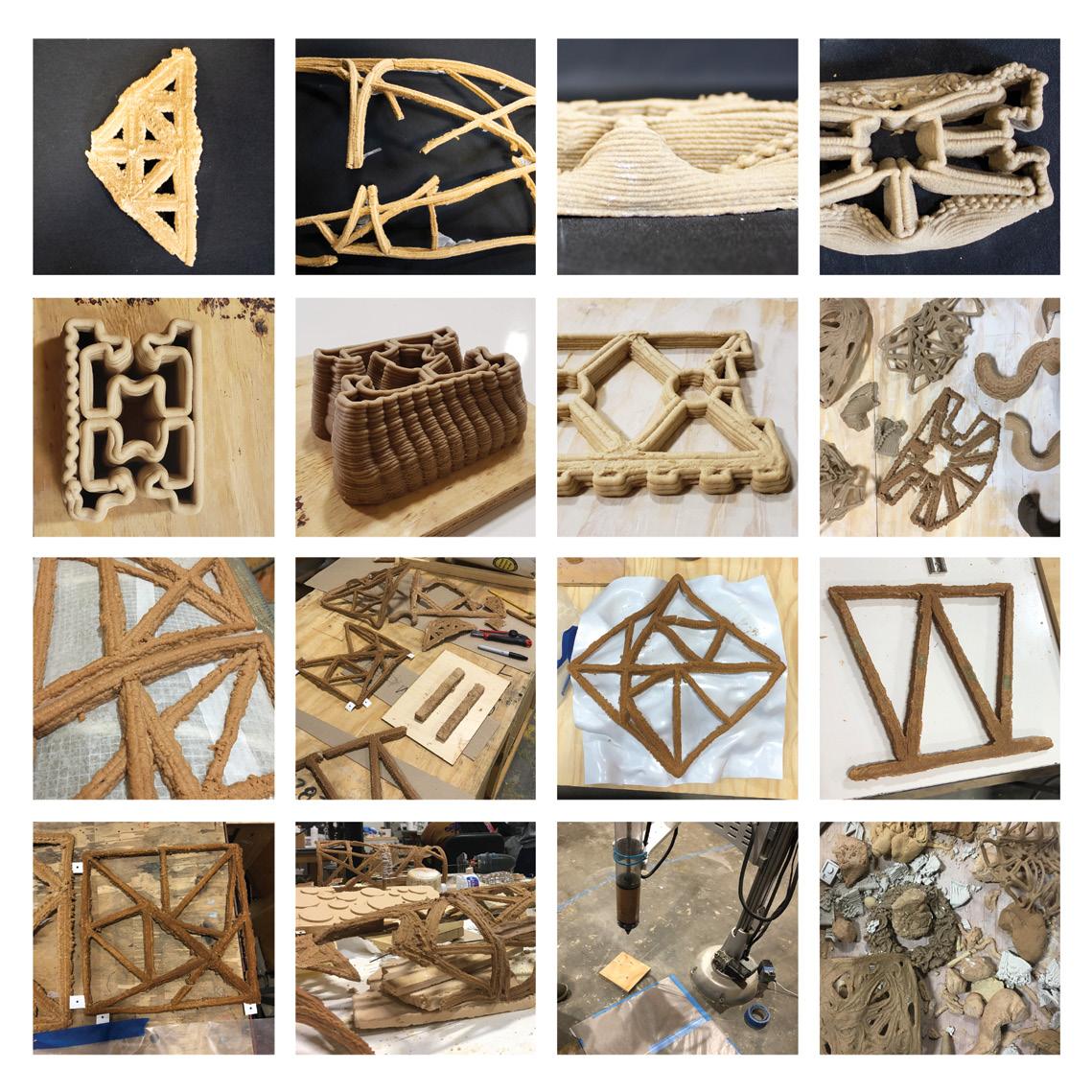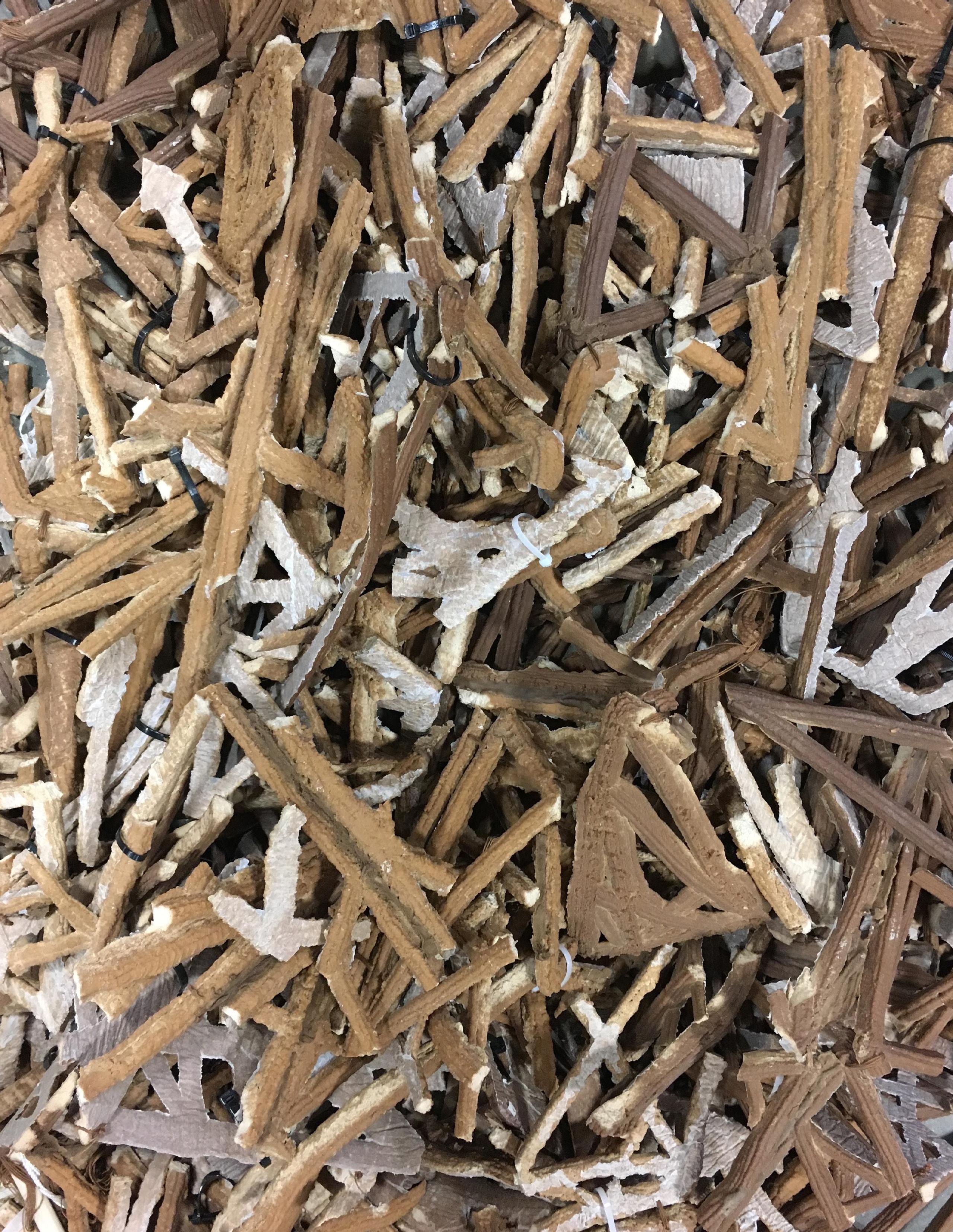
9 minute read
Futures of Wood
Michelle Parks
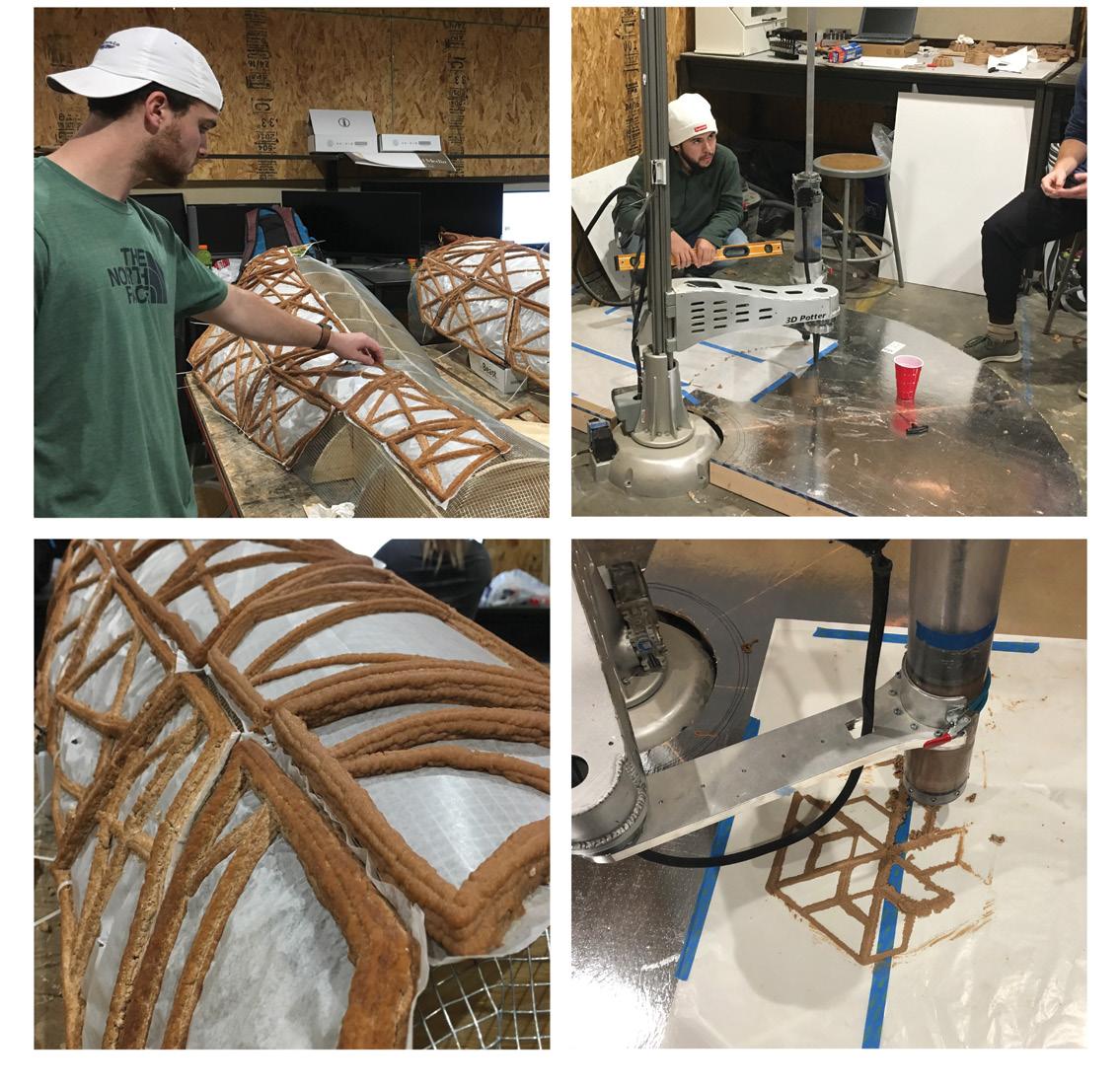
Advertisement
It was a semester of exploration and speculation, of uncertainty about how things might turn out. It was a time before the world faced a global pandemic and so many things that were anticipated or expected were suddenly up in the air.
In fall 2019, professor Frank Jacobus led a studio called The Future of Wood. The course was part of work being done by a larger team of University of Arkansas faculty researchers looking at innovative teaching practices that further the possibilities of cutting-edge timber and wood technologies.
The research team for the Chancellor’s Discovery, Creativity, Innovation and Collaboration Fund grant includes Jacobus, associate professor of architecture; Tahar Messadi, associate professor of architecture and the 21st Century Chair of Sustainability; Michelle Barry, assistant professor of civil engineering; John Pijanowski, professor of curriculum and instruction; Kimberley Furlong, associate professor of interior design; Richard Welcher, instructor in civil engineering; and Marty Matlock, professor of ecological engineering.
One aspect of the work involves developing ideas toward the Fay Jones School’s graduate program in wood design and innovation. With that Chancellor’s Fund support, Fay Jones School professors Messadi and Furlong had focused on mass timber and crosslaminated timber in an earlier semester studio.
So, for this fall 2019 semester, Jacobus partnered with Barry in civil engineering to develop an interdisciplinary course that continued to explore ideas and possibilities for future processes for wood and timber. There was a six-credit-hour studio for design students and a three-credit-hour lab for engineering students.
“We decided to do this because there’s a lot of byproduct that comes out of the wood production process, particularly sawdust,” Jacobus said. “In any mass timber — and especially CLT — construction, you lose about 15 percent of the material to waste.”
Their overarching question became: What could
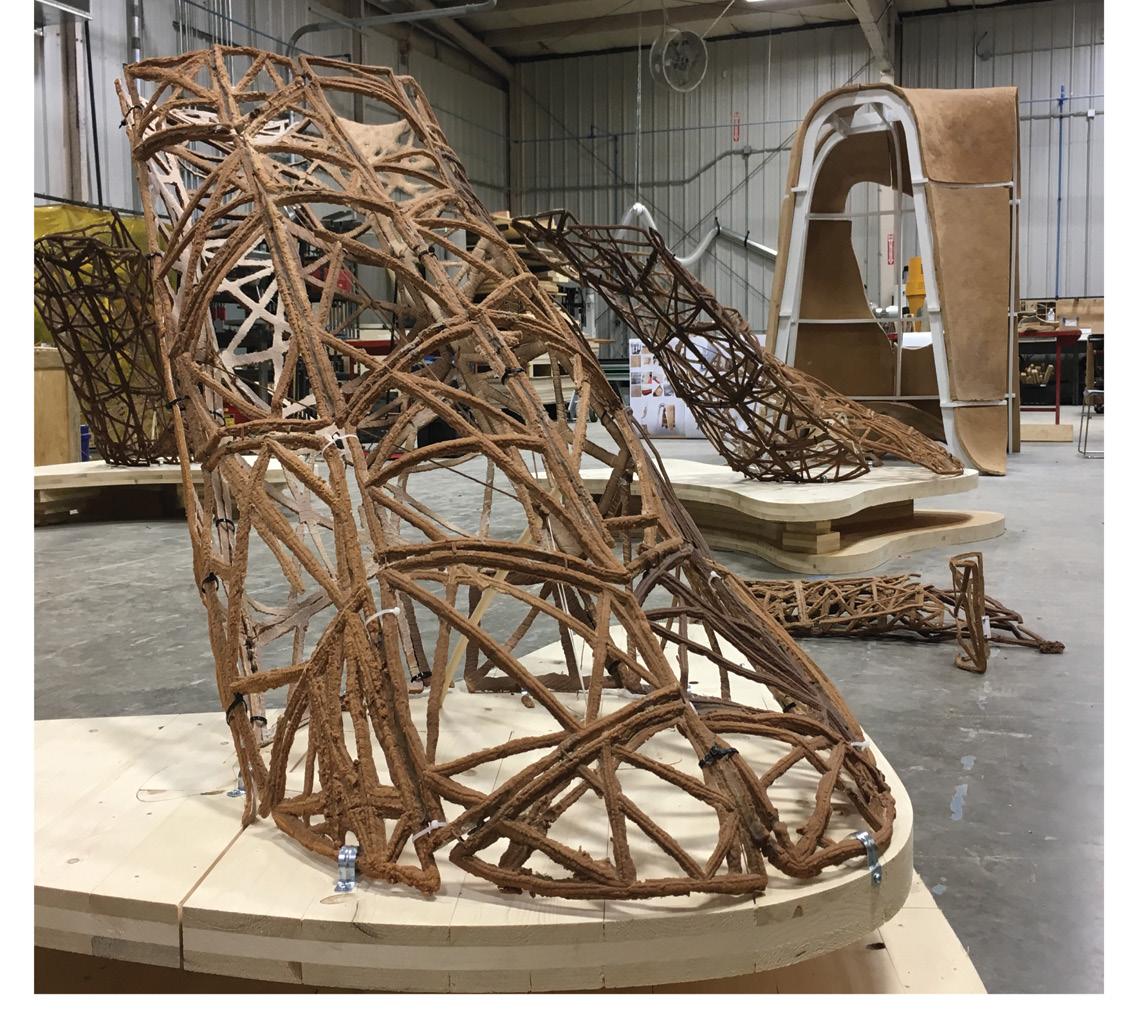
The 3D printed wood pavilion is shown in the foreground, with the cast wood pavilion in the background.
This set of images shows the process of wood printing. Students would print the material flat and then allow it to dry on a form. Once dry, it became rigid and took the shape of the form.
they do with this byproduct, this waste?
The Future of Wood studio examined various methods of using wood byproducts as a material — such as 3D printing of wood and even the casting of wood. “So, treating wood almost like it’s a concrete or some other material that can be cast,” Jacobus said.
When considering the sawdust, they knew that wood flour existed, which is “basically sawdust that’s been ground and processed down into a fine flour that very much feels like cooking flour,” Jacobus said. “It became a big question of, if there’s such a thing as powder-based printing, and now we have this wood powder or wood flour, could we print with wood? And some of this was total guessing and speculation.”
But architecture requires larger-scale pieces than a typical 3D printer can handle. So they wondered about using a robotic arm to 3D print the wood paste. And, Jacobus thought surely some professional designers were already doing this, but he couldn’t find any. So, the students started experimenting with printing and casting with wood materials, with the mindset of, “What would happen if…?”
“It was kind of uncharted territory for us, and I told the students this all along, that we’re getting into something that’s new, it’s different, and it’s probably going to be frustrating,” he said. “And I kind of knew going into it that it could be an utter failure. Because you don’t know what’s going to happen.”
For many studios, the path is better worn and the end result or product more known. A big part of this studio was embracing the messiness and uncertainty of this discovery process.
“So we had to kind of talk to each other as a group about how early and new processes are often messy processes,” Jacobus said. “That was a great lesson for the students; that was a great lesson for me.”
Early in that fall 2019 semester, the studio took a trip to Portland, Oregon, to study mass timber design happening in the Pacific Northwest. Back on campus, they only spent a bit of time with the 5-axis printing and then moved on and dug much deeper into casting and 3D printing. That’s when they became cooks in their kitchen, figuring out how to use their wood flour.
“Because we were doing this for the first time, and there wasn’t any kind of recipe out there for it, we had to actually invent our own recipes,” Jacobus said.
During the summer of 2019, Jacobus had a student research assistant, Matthew Scott, who had experimented with various recipes and ratios of ingredients, finally landing on a combination that was one-third each of wood, cooking flour, and regular Elmer’s glue.
Students in the fall 2019 Futures of Wood studio took that recipe and continued to develop it. They needed a recipe that would bind together but also one that would successfully print out of the school’s 3D PotterBot Scara printer.
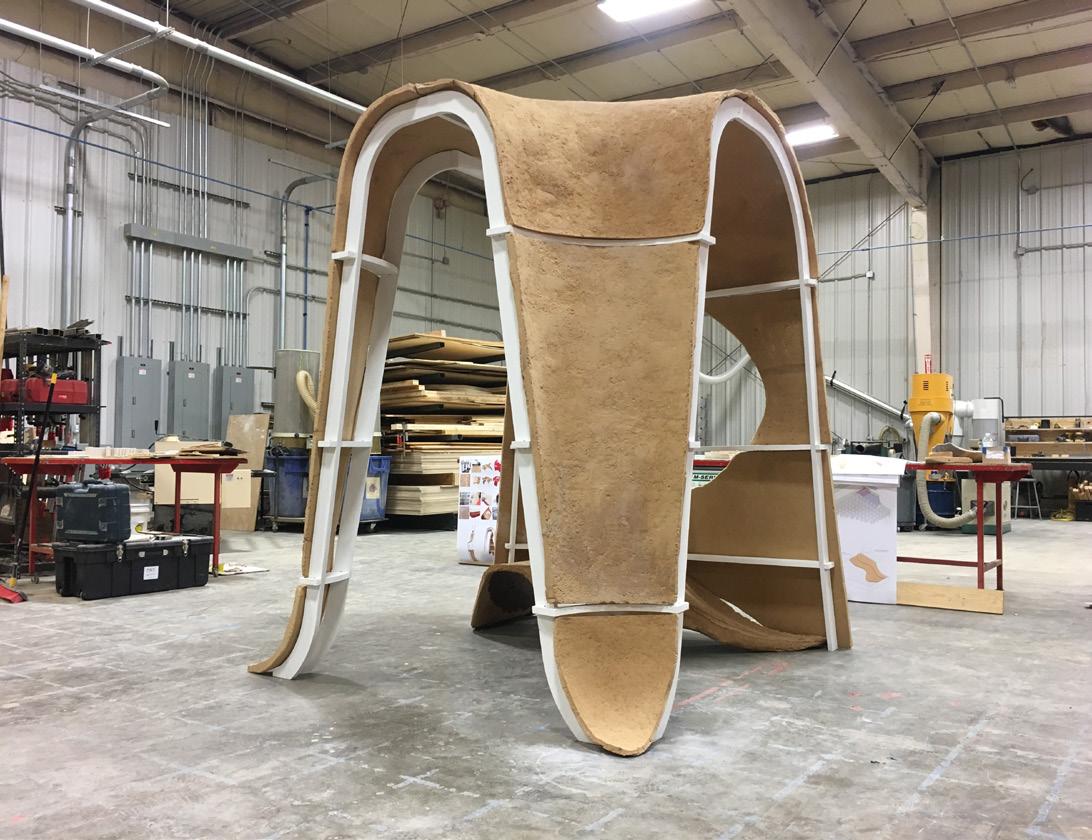
The cast wood pavilion.
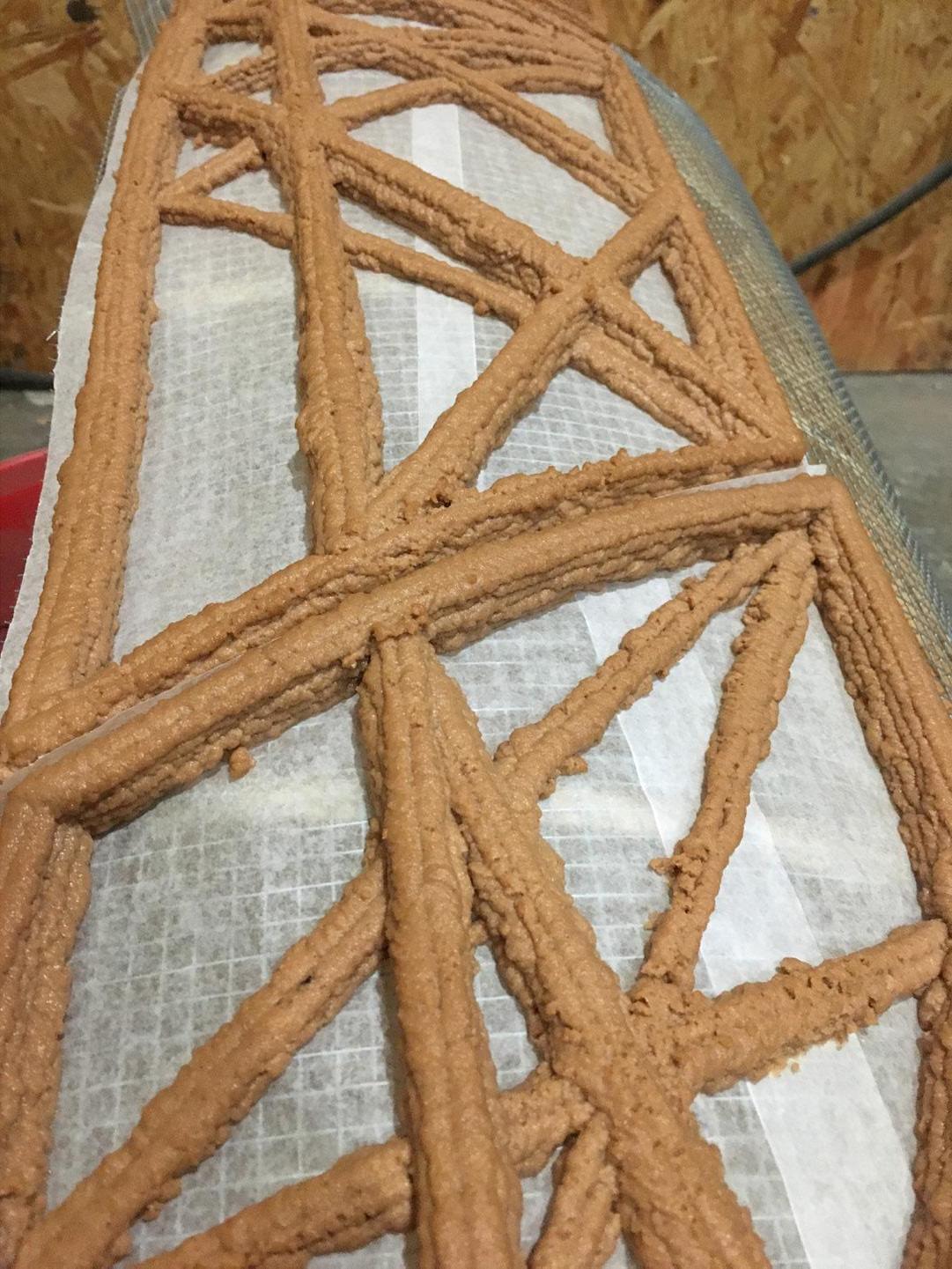
Wood paste material post printing, drying on the form.
Students conducted numerous printing and casting experiments to find the correct recipe.
Students present their work to the final review jury at the end of the fall 2019 semester in the Government Avenue Build Lab.

“It wasn’t just getting a paste; it was getting a paste that had the exact consistency that allowed it to print out of the PotterBot printer that we have,” he said. “And there were rats eating our experiment because it’s 33 percent cooking flour in there.”
One question for the future is: How do they find adhesives that are more sustainable? The adhesives they used were formaldehyde based and are not sustainable.
Experiments in Casting and 3D Printing
The studio had 11 architecture students and five interior design students. The students were divided into two teams — Team C for casting and Team 3 for 3D printing. Eventually, the goal became to achieve 80 percent wood in the mixture for the 3D printing and the casting process.
“That was a total guess on my part. I had no reason to say that number, but I knew there had to be enough adhesive in there to stick things together. And I just said 80 percent,” Jacobus said. “We didn’t get there, but we ended up getting, for the printed product, to 65 percent, which is pretty good. For the cast team product, we got to 80 percent.”
As they tested various recipes, they used ice cube trays and made their own forms. For the casting, they mixed different adhesives with the wood flour.
The result was various shapes with varying amounts of wood and resin or glues. For adhesives, they tested powder-based resins, animal hide glue, Elmer’s glue, and rice glue. As they tested, they observed that some were too flaky and broke apart easily.
With a civil engineer on the team, they also did break tests along the way to assess the properties as they experimented. And they carefully recorded the ingredients with each recipe and the properties of the resulting product.
“Each time you made the recipe, even if you changed a slight thing about the recipe, it would sometimes have a fairly radical effect on the outcome,” Jacobus said.
They developed forms for casting various shapes that used vinyl tape to allow the finished forms to
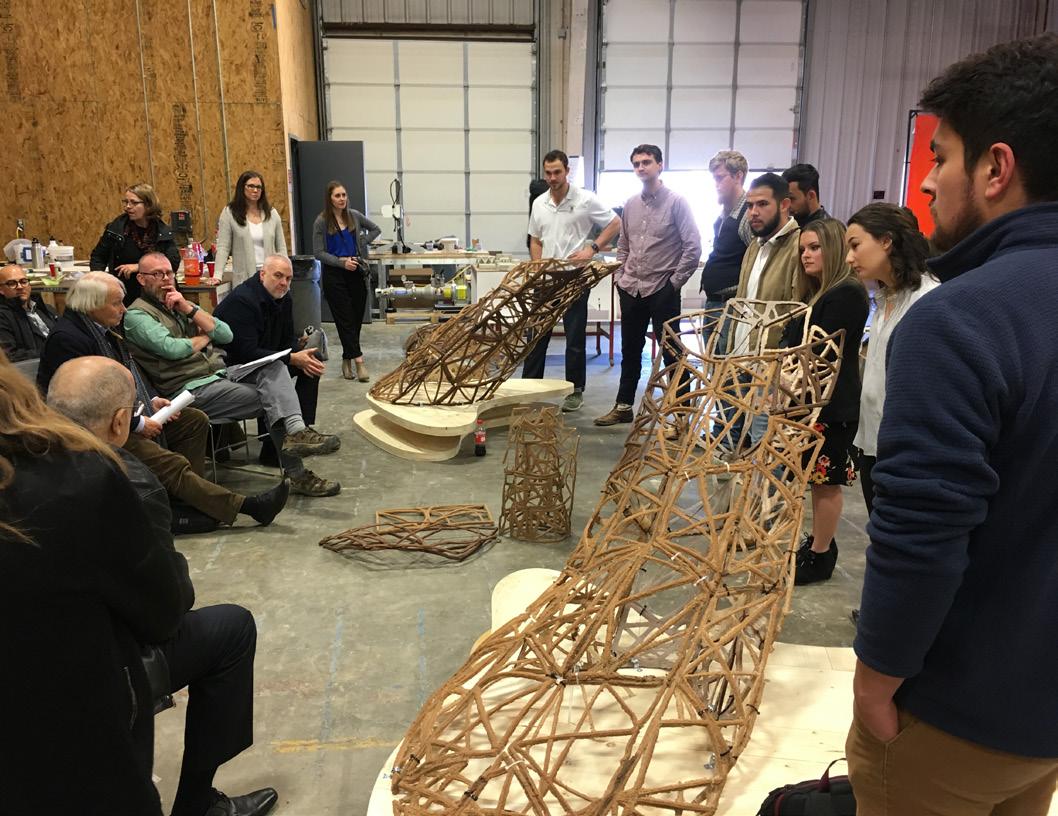
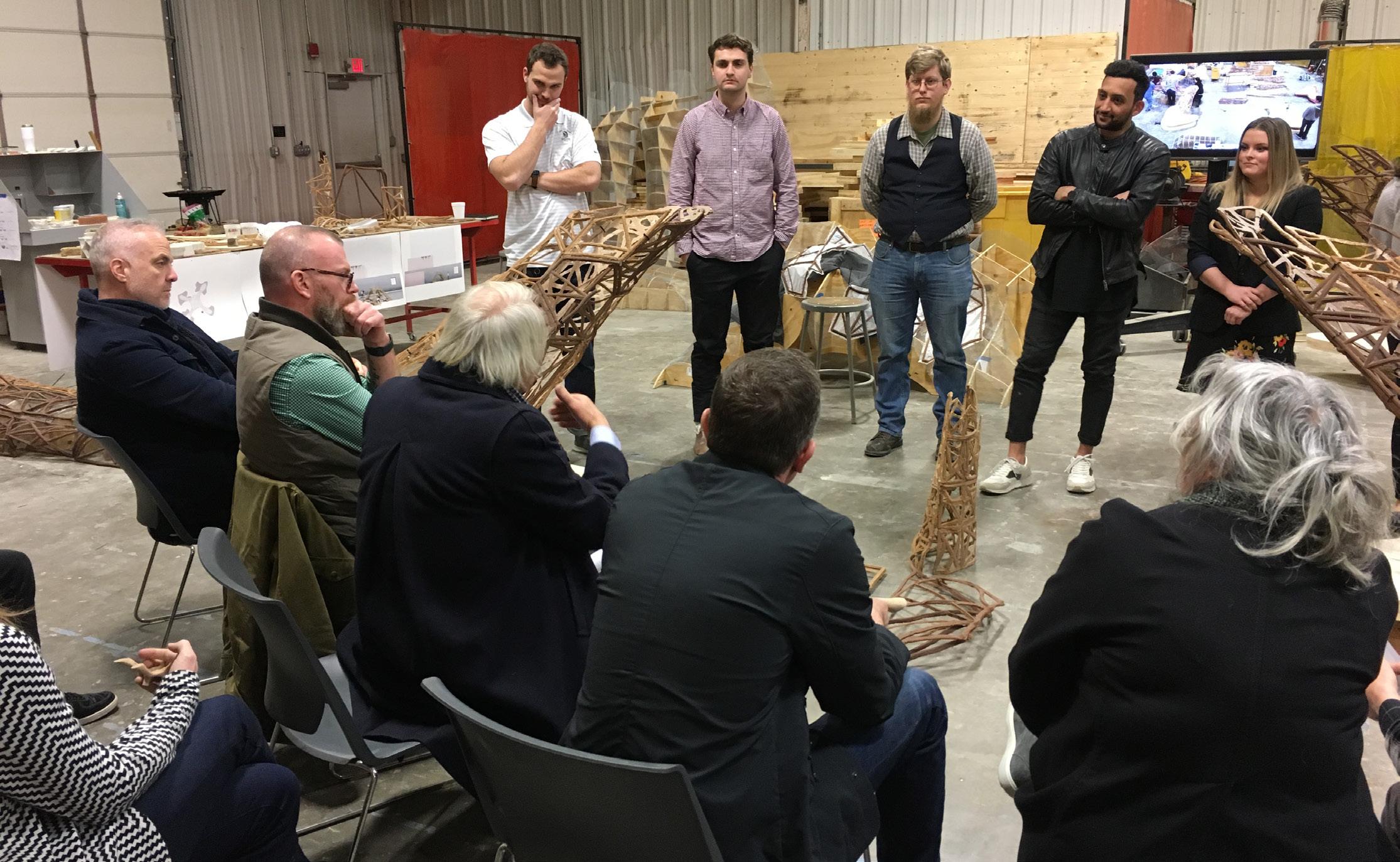
John Folan, Department of Architecture head; Jason Wright, principal, Modus Studio; Per Olaf Fjeld, professor, The Oslo School of Architecture and Design; Blaine Brownell, assistant professor, University of Minnesota School of Architecture; and Lynn Fitzpatrick, teaching assistant professor, critique the students’ work in the Government Avenue Build Lab during the final review in fall 2019.
The final cast wood pavilion is shown here with the vinyl taped forms into which the wood mixture was cast.
release from the molds. At one point, they made a brick and realized they could make building blocks similar to a concrete masonry unit that measured about 4 by 8 inches each.
“That’s where the students and I started to gain some faith in the process, just through seeing that,” Jacobus said. “We had these pieces that are like concrete, but they’re made out of wood, so they’re much more sustainable than concrete.”
The 3D printing team also designed a pavilion, which first meant printing a small model of their design. Then they fractured the whole design into smaller components and printed those individual pieces. They printed the pieces flat, then took the still-wet pieces and laid them over a curved form on wax paper to dry and harden. The pieces shrunk to some extent during the drying. In the end, they used a hide glue and sawdust mixture to hold the pieces together — resorting to zip ties in areas that became less stable.
The most important thing to come out of the studio wasn’t the resulting work, much of which was displayed on the tableau of Vol Walker Hall. The objects weren’t finished and refined like students and faculty are used to seeing at the end of a studio.
“It’s not the product that came out of it necessarily,” Jacobus said. “It’s that learning how
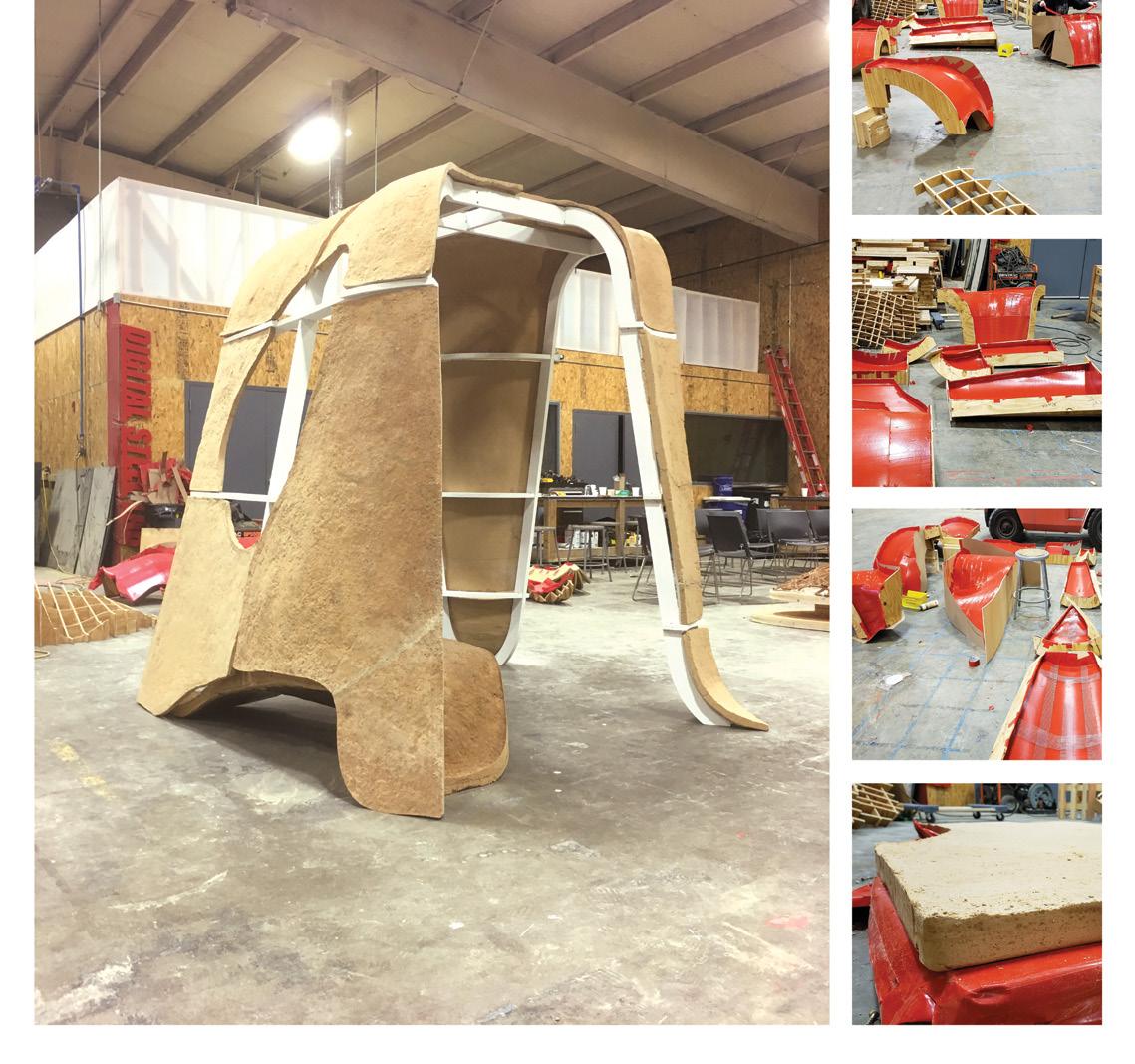

Emily Baker, assistant professor; Vincent Edwards, instructor, University of Arkansas School of Art; Per Olaf Fjeld, professor, The Oslo School of Architecture and Design; Jason Wright, principal, Modus Studio; and John Folan, Department of Architecture head, interact with students at the final review in the Government Avenue Build Lab in fall 2019.
Numerous printing experiments were done to refine the wood paste mixture and printing process.
to overcome challenging prompts and challenging situations. That’s really what I was most proud of.”
Students all learned new technologies that they hadn’t used before. And Jacobus was pleased to see in all of the students “just an ability to keep pushing forward and keep pursuing in a positive way. It was a good culture in the studio that way.”
The studio’s work was also featured in January 2020 by Architect magazine.
After that course, Jacobus has continued to work with Angie Carpenter, Fabrication Labs Manager, to further develop this research. One focus is simulating a robotic arm using an electric caulk gun to create forms.
The questioning remains the main focus of the research, to consider materials that are currently discarded during timber production as potential resources for new product and new material.
“What’s so exciting about this to me is that there’s still thousands of questions to ask, and many, many things to try to figure out to make a form that can be constructed,” Jacobus said.
